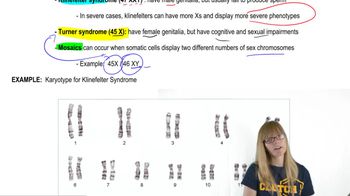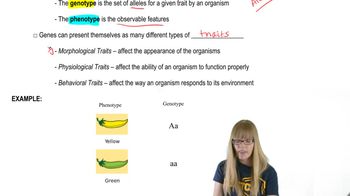Table of contents
- 1. Introduction to Genetics51m
- 2. Mendel's Laws of Inheritance3h 37m
- 3. Extensions to Mendelian Inheritance2h 41m
- 4. Genetic Mapping and Linkage2h 28m
- 5. Genetics of Bacteria and Viruses1h 21m
- 6. Chromosomal Variation1h 48m
- 7. DNA and Chromosome Structure56m
- 8. DNA Replication1h 10m
- 9. Mitosis and Meiosis1h 34m
- 10. Transcription1h 0m
- 11. Translation58m
- 12. Gene Regulation in Prokaryotes1h 19m
- 13. Gene Regulation in Eukaryotes44m
- 14. Genetic Control of Development44m
- 15. Genomes and Genomics1h 50m
- 16. Transposable Elements47m
- 17. Mutation, Repair, and Recombination1h 6m
- 18. Molecular Genetic Tools19m
- 19. Cancer Genetics29m
- 20. Quantitative Genetics1h 26m
- 21. Population Genetics50m
- 22. Evolutionary Genetics29m
3. Extensions to Mendelian Inheritance
Sex Chromosome
Problem 8
Textbook Question
What specific observations (evidence) support the conclusions about sex determination in Drosophila and humans?
 Verified step by step guidance
Verified step by step guidance1
Understand that sex determination in Drosophila is based on the ratio of X chromosomes to sets of autosomes (X:A ratio), whereas in humans, it is determined by the presence of the Y chromosome.
In Drosophila, observe that a ratio of 1.0 (e.g., XX:AA) results in a female, while a ratio of 0.5 (e.g., XY:AA) results in a male. This is supported by genetic experiments showing that altering the X:A ratio changes the sex.
In humans, note that the presence of the SRY gene on the Y chromosome is crucial for male development. Evidence includes cases of individuals with XY chromosomes but lacking the SRY gene, who develop as females.
Consider the role of specific genes and mutations in both systems. For example, in Drosophila, mutations in the 'Sex-lethal' gene can alter sex determination, while in humans, mutations in the SRY gene or androgen receptor can lead to sex development disorders.
Review experimental evidence such as karyotyping, genetic crosses, and molecular analysis that have been used to study and confirm these mechanisms in both Drosophila and humans.
Recommended similar problem, with video answer:
 Verified Solution
Verified SolutionThis video solution was recommended by our tutors as helpful for the problem above
Video duration:
3mPlay a video:
Was this helpful?
Key Concepts
Here are the essential concepts you must grasp in order to answer the question correctly.
Sex Chromosomes
Sex chromosomes are a pair of chromosomes that determine the biological sex of an organism. In humans, the presence of two X chromosomes typically results in a female (XX), while one X and one Y chromosome result in a male (XY). In Drosophila, the sex determination system is based on the ratio of X chromosomes to autosomes, where a ratio of 1.0 (two X chromosomes) leads to a female, and a ratio of 0.5 (one X chromosome) leads to a male.
Recommended video:
Guided course

Human Sex Chromosomes
Genetic Evidence
Genetic evidence refers to observations derived from the study of genes and their inheritance patterns. In Drosophila, mutations in sex-determining genes such as 'tra' (transformer) and 'dsx' (doublesex) provide insights into how sex is determined. Similarly, in humans, genetic disorders related to sex chromosomes, such as Turner syndrome (XO) and Klinefelter syndrome (XXY), illustrate the role of sex chromosomes in determining sexual characteristics.
Recommended video:
Guided course

Descriptive Genetics
Environmental Influences
Environmental influences can affect sex determination in some species, although this is less pronounced in Drosophila and humans. In certain reptiles, for example, temperature during incubation can determine sex. Understanding these influences helps clarify the complexity of sex determination mechanisms across different organisms, highlighting that while genetic factors are primary, environmental conditions can also play a role in some species.
Recommended video:
Guided course

Maternal Effect

 4:24m
4:24mWatch next
Master Sex Determination with a bite sized video explanation from Kylia Goodner
Start learningRelated Videos
Related Practice


